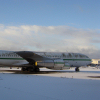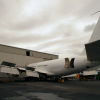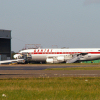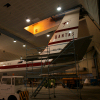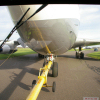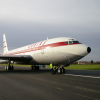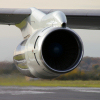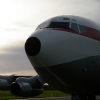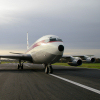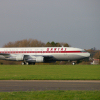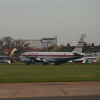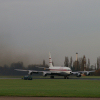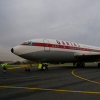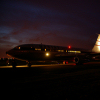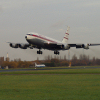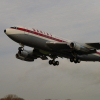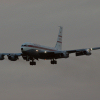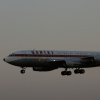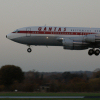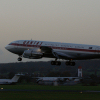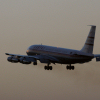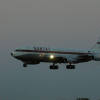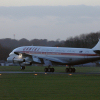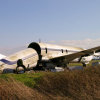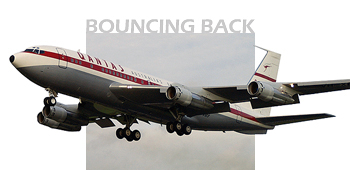
Qantas Boeing 707 Feature Report
Saturday 30th August
As Boeing 707-138 VH-EBA lifted off from Sydney's runway at 16:00 on 29 August 1959, bound for San Francisco, a new age dawned for the vast continent of Australia. Until that inaugural passenger flight the Antipodes had been days from anywhere, but in an instant that was reduced to hours as the jet age chalked up yet another milestone. Rolling out of Boeing's Renton plant on 11 February of that year and originally named 'City of Canberra' - within a few months changed to 'City of Melbourne' - serial number 17696 became the first jetliner Boeing ever sold to a foreign customer. It was also the first commercial jet to be exported out of the US, the first jet to be operated by QANTAS and registered in Australia, and is the oldest of this version still in existence, and potentially the oldest 707 flying.
reports on the remarkable restoration of a true classic. Additional photography by .
Eight years of proudly sporting the kangaroo on its tail, and a similar period with Pacific Western Airlines was followed by an assortment of operators and uses, until finally being conscripted into the Royal Saudi Air Force for use by Prince Bandar, Saudi Ambassador to the USA. Registered as HZ-123 and with an interior fitted out as a luxury executive business jet, furnished in dark polished wood, with all the trimmings befitting the Prince, the 707 enjoyed a well-deserved rest from plying the passenger airways, taking on a more stately life befitting her age.
At the turn of the millennium, the aging Boeing found itself in storage at Southend airport facing an uncertain future. The Essex airport has seen the axe-man cometh and taketh away many a retired airliner, especially those that no longer comply with the stricter-level noise regulations that would limit any further service. The weather began to take its toll, and her once proud exterior finish became soiled and stained. Sitting forlornly amongst the airport detritus, her history was not obvious to the casual observer, but thankfully, on the other side of the world, moves were in hand not only to rescue the 707, but also to take it 'home'.
An expeditionary team from 'Down Under' carried out a survey of the airframe in November 2005, and surmised that a return to flight was feasible, assuming the necessary funds could be found. The project being run by the QANTAS Founders Museum of Longreach (which at that time had a 747-200 on display) received a grant of $1,000,000 from the Australian government, and the wheels were set in motion. Current and former QANTAS air and ground crews volunteered to help with the undertaking, and a team from Boeing joined the workforce.
By July 2006, the jetliner was officially registered as VH-XBA to the Foundation (with VH-EBA currently allocated to an A330, once of QANTAS' modern fleet, before moving on to Jetstar Airways ), and the QANTAS team were hard at work restoring it to an airworthy condition. Resplendent in an all white scheme and moved to ATC Lasham's apron, the original target for the first flight was early October, but this was clearly optimistic for an aircraft that hadn't flown for six years. As the QANTAS Founders Museum Chairman, Warwick Tainton says, "The aeroplane, even though it's nearly fifty years old, was very advanced for its time and aeroplanes are extremely technical beasts. This aircraft has had to be pulled right down to basics and rebuilt. It's been a terrific effort on many people's behalf. The resurrection of the aeroplane is probably the most technically advanced project of its kind ever undertaken in the world by volunteers. It's really quite significant.".
Those volunteers had to continue working through October and November as continuing faults occurred, and problems with the number two engine required its removal at a time when first flights were imminent.
Finally, on the last day of November, 'XBA taxied under her own power, and then, in the afternoon of Saturday 2 December, Captain Murray Warfield pulled back on the yoke and lifted the wheels clear of Southend's runway, sporting the same colours that she wore nearly fifty years previously, on that first passenger flight.
Warwick Tainton said, "This has been a fantastic testimony to the more than 15000 man hours put into the aircraft over the last 6 months by our very dedicated team of volunteer engineers. I understand they had a bit of hesitance handing over their baby to 'those pilots who only ever break things'". Although the two and a half hour test flight was considered as a success, it did throw up a number of 'snags' which further delayed the final departure - a departure that would most likely be the last ever 707 movement under power at an airport that is steeped in the type's later history. A chapter in the story of the Essex airport may be closing, but that final paragraph tells the tale of an amazing project, testament to the willingness of individuals to save an old and near forgotten relic of a bygone age.
On Friday 8 December, 2006, in the morning of a typically cold and wet British winter's day, QANTAS 707 VH-XBA did just that, leaving behind a single sister-ship that would indeed succumb to the scrap man and heading off on a route that would take in some slightly more exotic locations - and much warmer temperatures - the classic Boeing really was going home: a most incredible achievement. Stopping at Dublin, Tenerife, Bermuda, Orlando, Los Angeles, Honolulu, Nadi (Fiji), before landing at Sydney on 16 December, and her temporary home, she was treated like a visiting film star, at one point meeting up with John Travolta's similar vintage 707 . Around seven months later the 707 would make the final short flight to the QANTAS Founders Museum at Longreach, and become a museum piece, telling her adopted country about her exploits, and her place in history.

